Abstract
Along with the principal rare earth (REE) minerals such as monazite, xenotime, and bastnasite, Y-and REE-bearing zircon and associated minerals survive the combustion process and are found in coal-combustion fly ash. Beneficiated fly ash from a power plant burning an eastern-Kentucky-sourced coal blend was found to have zircon (ZrSiO4), baddeleyite (ZrO2), fergusonite (YNbO4), yttriaite (Y2O3), and xenotime (YPO4). Previous studies of the same fly had also identified monazite with a broad REE suite. Scanning electron microscopy–electron dispersive spectroscopy (EDS) and transmission electron microscopy (TEM)–EDS as well as other TEM-based techniques revealed a variety of zircon associations, including heavy-REE suites with Y, Nb, and Hf. Hafnium is a common accessory element in zircons and the Y and Nb may be present as fergusonite (YNbO4) intermixed with zircon.
1. Introduction
The interest in extracting critical elements from coal and coal-combustion products has had a bias towards rare earth elements (REE) [1,2] although funded programs [3,4] have broadened the view towards elements other than the REE. The latter four references deal with some of the most recent technology for the extraction and concentration of REE and other critical elements from coal-combustion products. Similarly, with respect to minerals, much attention has been paid to the major REE-bearing minerals (monazite, xenotime, bastnasite) that occur in coal and, in most cases, are also found in the Al-Si-rich glass-dominated (for low-Ca eastern US bituminous coal ashes) coal-combustion fly ash. Zircon, an important Y- and REE-bearing mineral in coals, also survives the combustion process and is found in fly ash. As an example, Hower et al. [5] reported REE-Y-Hf-bearing zircon from the stoker ash.
Berti et al. [6] outlined the scanning and transmission electron microscopy–electron dispersive spectroscopy (SEM-EDS and TEM-EDS, respectively)-based fingerprints of the extraction of REE from a beneficiated fly ash. Particular attention was paid to monazite and the fly ash glass with nanometer-scale minerals in both the beneficiated ash and the spent ash following the acid extraction of REE. It is emphasized that all fly ashes are unique; the ash studied here and by Berti et al. [6] is from an eastern Kentucky coal blend. The REE chemistry of the ash resembles fly ashes derived from the combustion of the Fire Clay coal [7]; the REE signatures of those ashes differ from the REE distributions in other Appalachian coal-derived ashes and the ashes from other regions. While the source of the Fire Clay zircons and REE-bearing minerals was, in part, a volcanic eruption [8], it is acknowledged that mineralogy can be complex and intimate associations of xenotime and zircon [9,10] and monazite and clay [11] can occur. While there was a greater concentration on the phosphate-based lanthanides and their acid extraction in the earlier study [6], in this study, the focus is on the REE and Y content in zircons from the beneficiated ash.
Zircon transforms to zirconia (ZrO2-t) and cristobalite between 1285 and 1720 °C [12]. Based on their experimental studies, Butterman and Foster [13] indicated that the upper limit of zircon stability is 1676 ± 7 °C. Metamict zircon and fergusonite (ideally YNbO4) can have a disrupted crystal structure and develop a porous structure upon heating to 1100 °C [14,15]. Siégel et al. [16] provided an overview of the use of zircons in determining magmatic temperatures. Elemental composition plays a role in determining the melting temperature of other REY mineral sources in coals, with Er-xenotime melting at 1896 °C up to Y-xenotime at 1995 °C, Sm-monazite melting at 1916 °C up to La-monazite at 2072 °C, and natural monazite melting at 2057 °C [17]. With the exception of the low end of the Quercia et al. [12] estimates for zircon, all of the zircon, xenotime, and monazite melting temperatures exceed the 1400–1500 °C range of pulverized-fuel combustion.
Phase studies of the Y2O3–ZrO2 (+/−Gd2O3) systems are of interest in electrical engineering and ceramic science [18,19]; among others. At 1500 °C, Roth [18] notes a transition from a Y2O3 solid solution to (Y2O3)6 ZrO2 at about 84:16 Y2O3:ZrO2 to (Y2O3)6 ZrO2 + cubic ZrO2 solid solution at about 75:25 Y2O3:ZrO2 to a cubic ZrO2 solid solution at 48:52 Y2O3:ZrO2. From 1500 °C to about 1600 °C, Fabrichnaya and Aldinger [19] describe a bixbyite structure ((Gd3+, Y3+, Zr4+)2 (O2−)3 (O2−, Va); where Va is a vacant position with random occupancy) from 10:90 to 35:65 Y2O3:ZrO2. From the latter point up to 15:85 Y2O3:ZrO2, a fluorite structure [(Zr4+, Gd3+, Y3+)2 (O2−, Va)4] is the Zr-Gd-Y phase. The latter is similar to Roth’s [18] (Y2O3)6 ZrO2 phase. A key point related to the melting of zircon, fergusonite, xenotime, and monazite and the phase transformations of Y- and Zr-rich minerals is that, within the coal-fired boiler, the path from the injection of the coal into the boiler to the combustion temperature to the cooling and passage of the fly ash through the convective pass to the ash-collection system (in this case, electrostatic precipitators) is rapid, and the mineral systems are not in equilibrium. A 40:60 Y2O3:ZrO2 ratio takes on a different meaning in the case of adjacent mineral grains, for example, fergusonite bordering zircon, than it would in the case of a fine-powder 40:60 Y2O3:ZrO2 mix of the respective oxides.
2. Materials and Methods
2.1. Beneficiation
As part of a project aimed at producing REE from coal combustion fly ash, a Kentucky utility shipped about 12 tons of fly ash to the University of Kentucky Center for Applied Energy Research (CAER) in August 2018. The beneficiated fly ash studied here (sample 94097) was produced via froth flotation and magnetic separation processes to reduce the amount of carbon and magnetite, respectively, followed by screening to produce a <200-mesh (<75-μm) product [20]. The beneficiated ash product was shipped to Winner Water Services Inc. (Sharon, PA, USA) for the pilot-scale acid-based extraction of REE following the Joshi et al. [21] procedure [22]. Detailed analysis of the fly ash following REE extraction is found in Berti et al. [6]. The fly ash is archived at the Kentucky Geological Survey’s Earth Analysis Research Library.
2.2. Scanning Electron Microscopy–Energy Dispersive Spectroscopy (SEM-EDS)
An epoxy-bound pellet of beneficiated fly ash (sample 94097) was prepared to a 0.05-µm alumina final polish and sputter coated with carbon to render the surface conductive. The surface was analyzed using a Thermo Fisher/FEI Versa 3D DualBeam scanning electron and focused ion beam microscope (FIB-SEM; Thermo Fisher Scientific, formerly FEI, Hillsboro, OR, USA). The Versa 3D is equipped with a backscatter detector (BSE) to collect atomic number contrast images in which heavy minerals or particles hosting heavy atoms dispersed in a matrix composed of aluminum silicates appear bright. The chemical composition of fly ash particles was determined by energy dispersive x-ray spectroscopy (EDS) using an EDAX Octane Ultra Pro silicon drift detector (EDAX, Pleasanton, CA, USA) solid-state detector mounted on the Versa 3D. The EDS spectra were collected using a voltage of 15 to provide sufficient overvoltage to excite most elements (including lanthanides) while retaining a spatial resolution of approximately 1 µm and 30 keV to verify the identification of Y and Zr.
2.3. Transmission Electron Microscopy (TEM) and Spectroscopy
Based on the SEM-EDS analyses, an area from the epoxy-bound pellet of sample 94097 was selected for more thorough analysis. The Versa 3D DualBeam was used to extract and lift out a thin slice, with an approximately 10-µm by 7-µm area, of the promising mineral assemblage and fly ash. The slice was mounted on a Cu grid and ion milled to approximately 100 nm thickness for analysis with a Thermo Fisher Spectra 300 cold field-emission scanning transmission electron microscope (TEM; Thermo Fisher Scientific, Hillsboro, OR, USA), operated at 300 keV. TEM images and selected area electron diffraction patterns (SAED) were acquired with a Thermo Fisher Ceta CMOS camera. Elemental composition at sub-nanometer resolution was collected by EDS using a DualX EDS detector system (Bruker, Billerica, MS, USA), consisting of two symmetrically positioned 100 mm2 windowless silicone drift detectors, operating the TEM in scanning mode. Additional elemental information was obtained by electron energy-loss spectroscopy (EELS), using a post-column Gatan GIF BioContinuum HD imaging and energy filter equipped with a K3 single-electron detector (Gatan, Pleasanton, CA, USA). The TEM was operated in scanning mode, using a C2 aperture of 50 µm, a camera length of 600 mm, and an entrance aperture of 5 mm, amounting to a convergence semi-angle of 8.1 mrad and a collection semi-angle of 38.3 mrad. Dual EELS spectra [23] were acquired in the low energy range (0–1250 eV) and high energy range (1350–2600 eV) at a dispersion of 0.23 eV/pixel. In Dual EELS, the two energy ranges were collected in rapid succession to allow removal of any energy shift and evaluation of sample thickness using the low-loss (LL) region in concurrence with the identification and quantification of elements based on their high energy-loss (HL) features. The Gatan Microscopy Suite (GMS) was used to calculate the relative sample thickness, in units of local inelastic mean free path (t/λ), using the log-ratio method [24] for background extraction and a power-law model, and quantification. For a thorough elaboration of the TEM characterization and FIB liftout technique for geologic samples, the reader is referred to Stroud and Singerling [25]. The EDS scans of areas of interest were examined by plotting the data with SigmaPlot version 15 (Grafiti LLC, Palo Alto, CA, USA) and selecting energy (eV) and count ranges for enhancement. Mineralogical identification of grains was based on chemical composition and crystal structure data obtained from SAED and HRTEM. The same GMS image analysis software used to analyze the EELS spectra was also used to measure crystal structure parameters from SAED and HRTEM. For HRTEM images, lattice spacing and angles were measured from the corresponding Fast Fourier transform (FFT).
3. Results
3.1. SEM-EDS
The EDS data for all of the analyzed points are in the Supplementary Materials.
In the case of Area 1 (Figure 1), only the 30-kV scan (1-6) is plotted; points 1-2, 1-3, and 1-4 are Al-Si glass with a minor concentration of Zr being detected. Note that for all of the SEM-EDS scans (Figure 2 for this mineral), the element distribution represents a volume [26], thus potentially including information from hidden minerals and the Al-Si-rich fly ash glass. In Figure 2A, the Zr Lα and Nb Lα peaks overlap with P peaks. However, there are not any humps, particularly on the 2 keV side (the location of the P Kα peak at 2.013 keV), that would suggest that P is present. REE peaks in the 4–9.25 keV range (Figure 2B) are obscured by the Ti and Fe peaks. The Hf Lα in the latter range is an expected accessory element in zircon (ZrSiO4). The 14–18.25 keV range (Figure 2C) has strong Zr Kα and Zr Kβ peaks, but Y, a common accessory element in zircons, does not occur at a detectable concentration. The higher concentration of Zr compared to Si (Figure 2A) and the absence of REE (Figure 2B) and Y (Figure 2C) suggest that baddeleyite (ZrO2) may be present with zircon.

Figure 1.
SEM-BSE image of area 1 showing the spots measured by EDS. The bright area (spots 1-1, 1-5, and 1-6) are on baddeleyite (ZrO2), possibly in association with zircon (ZrSiO4). Spots 1-2, 1-3, and 1-4 are largely associated with an Al-Si-rich glass.

Figure 2.
Area 1, EDS spectrum 1-6. Energy vs. counts for (A) 1.4–2.5 keV, (B) 4–9.25 keV, and (C) 14–18.5 keV.
Figure 3 shows a mineral shard on which the three areas could be scanned. The areas for 2-1 and 2-3 have near-equal counts of Si and Zr (Figure 4A), an anticipated characteristic of zircons. The Si and Al counts are higher than those for Zr for area 2-2 (Figure 4A) and K is present in 2-2 (Figure 4B), suggesting that more of the fly ash glass was being analyzed in 2-2 than in the other two spots. The presence of Cl is thought to be due to contamination from the pellet preparation process. Iron and Ti are seen in the 4–9.25 keV range along with Hf and, perhaps, Yb (Figure 4C). The 14–18.25 keV range (Figure 4D) has strong Zr Kα and Zr Kβ peaks along with a weak Y peak.

Figure 3.
SEM-BSE of area 2 showing the EDS-measured spots on zircon.
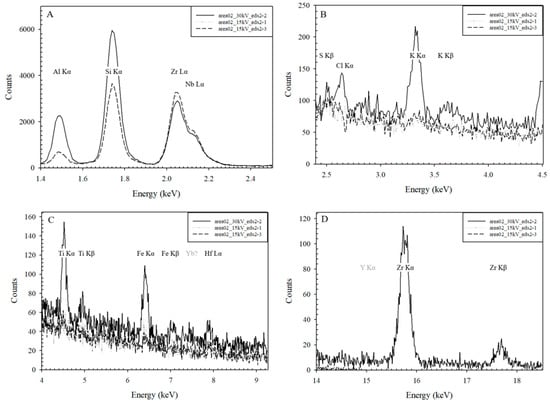
Figure 4.
Area 2 SEM-EDS spectra energy vs. counts for (A) 1.4–2.5 keV, (B) 2.4–4.5 keV, (C) 4–9.25 keV, and (D) 14–18.5 keV.
Five areas could be measured on the mineral shown in Figure 5. Area 3-5 (Figure 5B) is near area 3-1 (Figure 5A). All areas showed near-equal proportions of Zr and Si with Y Lα present in 3-1 and 3-5 (Figure 6A). Potassium and Sc are observed in the 2.4–4.5 keV range (Figure 6B). With the overlap of the ranges, the Sc Kα peak is also seen in the 3.8–9.25 keV range, along with Ti Kα and Ti Kβ, a suite of REE from Nd to Yb (and possibly Lu) with the Fe peaks obscuring the Dy and Er locations, and Hf (Figure 6C). The 14–18.5 keV range for area 3-5 includes strong Zr Kα and Zr Kβ peaks and a significant Y Kα peak (Figure 6D).

Figure 5.
SEM-BSE image of the area 3 zircon, with marked EDS: (A) spots 3-1 through 3-4; (B) area 3-5.

Figure 6.
Area 3 SEM-EDS spectra energy vs. counts for (A) 1.4–2.5 keV, (B) 2.4–4.5 keV, (C) 3.8–9.25 keV, and (D) 14–18.5 keV.
The complete array of area 4 spots is shown in Figure 7A, and the three points analyzed at 30 kV are shown in Figure 7B. Compared to the Si peaks, the Zr and Nb area is suppressed compared to the previous mineral grains (Figure 8A). The strong K peaks (Figure 8B) combined with the Al-Si intensity (Figure 8A) suggest that the EDS signal was more influenced by the fly ash glass than by the minerals. The Ti and Fe peaks dominate the 3.8 to 9.25 keV range, eliminating the possibility of seeing Ce, Dy, or Er (Figure 8C). The intensity of the Yb and Hf signals does not rise to the level of significance. In the 14–18.25 keV energy range, the Zr peaks for areas 4-4, 4-5, and 4-6 are significant (Figure 8D), but at a lower intensity that the Zr peaks seen in area 3-5 (Figure 6D).
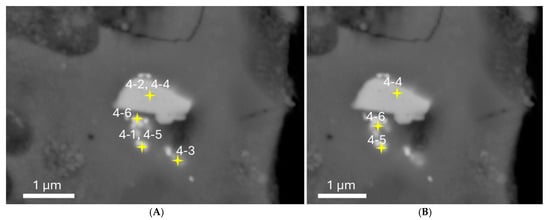
Figure 7.
SEM-BSE of area 4 showing the SEM-EDS spots on Al-Si glass with minor concentrations of zircon: (A) all points; (B) 4-4 through 4-6.

Figure 8.
SEM-EDS spectra energy vs. counts for (A) 1.4–2.5 keV, (B) 2.4–4.5 keV, (C) 3.8–9.25 keV, and (D) 14–18.5 keV.
Overall, the SEM-EDS analysis of four sets of mineral grains shows that some chemical variation is to be expected. Whether the Zr mineral is baddeleyite (ZrO2) or zircon (ZrSiO4), the analysis may encompass a larger volume than just the mineral. Fly ash glass was an unavoidable part of some, if not all, of the analyses, and Fe- and Ti-bearing minerals were also present in the analyzed volumes. Within the zircon, REE and Hf are found as accessory elements, and fergusonite-(Y) (YNbO4) can be intermixed with zircon [27,28,29]. Within the suite of grains analyzed here, the zircon represented by area 3-5 has significant showings of all of the latter elements.
3.2. TEM-EDS
The zircon grain from Figure 5 was selected for focused-ion-beam liftout and subsequent further examination via TEM and associated techniques. The bright field TEM (BF-TEM) and High-Angle Annular Dark-Field (HAADF) images of the zircon crystal are shown in Figure 9A,B. Closer examination of the edge of the crystal shows that the edge is porous and contains Y-rich areas (Figure 9C–F). The increased concentration of Y along the porous edge (the lower portion of Figure 10A) is seen in Figure 10B, the Y-Zr-C element map (the C is from the epoxy used to mount the particulate pellet), and Figure 10E, the Y map. Both zircon and fergusonite can contain radionuclides, leading to a metamict structure. As noted above, Chen et al. [15] attribute the porous structure of fergusonite to the heating of the metamict Y-fergusonite to temperatures above 1100 °C, well within the range of coal-combustion temperatures. Chen et al. [15] give the following formula for the metamict fergusonite used in their study: (Y0.70Ln0.20Ca0.13U0.02Th0.02)∑1.07(Nb0.72Ta0.17W0.06Ti0.04)∑1(O3.97(OH)0.11F0.08Cl0.03) 2.12H2O. The EDS spectrum for the map 55 area shows strong Si Kα and Zr Lα peaks of similar magnitudes with a possible Nb Lα peak on the shoulder of the Zr Lα peak (Figure 11A), weak Ti and Fe peaks accompanying the strong Hf peaks in the 4500 to 9200 eV range (Figure 11B), and strong Zr Kα and Zr Kβ peaks and a relatively weak Y Kα (and a vanishingly small Y Kβ peak) in the 14,000 to 18,500 eV range (Figure 11C). No peaks for U or Th could be identified. Despite the occurrence of Y near the edge, the Y is diluted in the zircon-dominated map area.
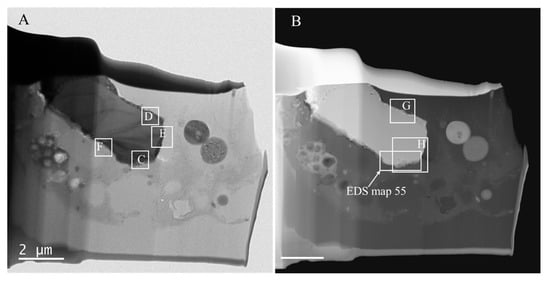
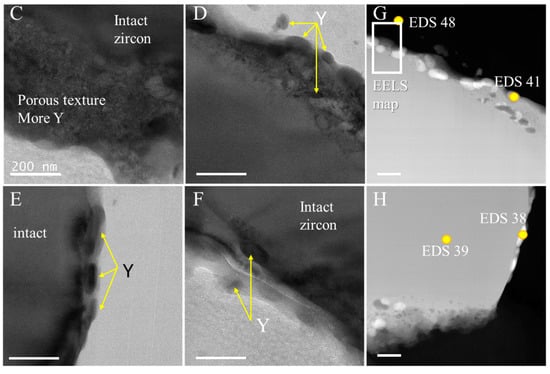
Figure 9.
Bright field TEM (A) and High-Angle Annular Dark-Field (HAADF) (B) images of focused-ion-beam section of Figure 5 zircon; the scale bar is 2 µm in both. The locations of the 200 nm scale BF-TEM images in (C–F) are shown in (A). The locations of HAADF images in (G,H) are seen on (B). EDS locations 41 and 48 are on (G) and EDS locations 38 and 39 are on (H). The location of EDS map 55 is shown on (B). Yttrium (Y) enriched areas indicated by yellow arrows.

Figure 10.
EDS Map 55. (A) HAADF image and (B–F) element maps for Zr + Y + C (as indicated by different colors), Si, Zr, Y, and Ho. Scale of 200 nm applies to all of the images.
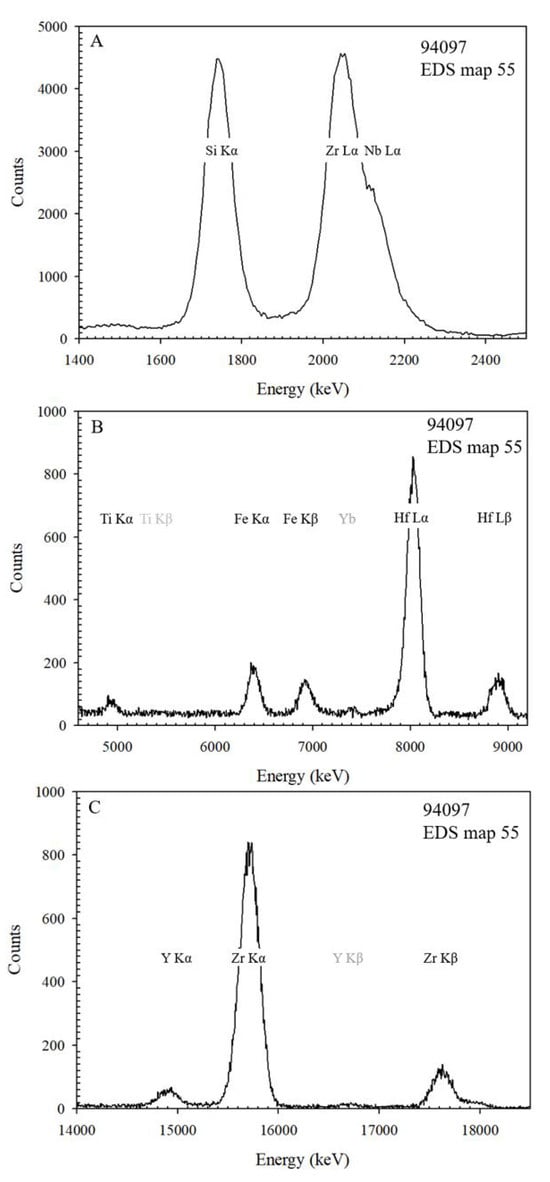
Figure 11.
EDS Map 55 sum spectrum energy vs. counts for (A) 1400–2500 eV, (B) 4500–9250 eV, and (C) 14,000–18,500 keV.
The four element distributions associated with the EDS spot analyses (locations in Figure 9B,F,G) illustrate the complexity of the mineral associations. Spot 39 (Figure 9H) with near-equal Si Kα and Zr Lα peaks and an Nb Lα shoulder on the Zr Lα peak (Figure 12A); significant Hf peaks (albeit, the least intense of the four EDS spots; Figure 12B); and, as seen in Figure 12C), strong Zr Kα and Zr Kβ peaks without a significant Y Kα peak (and no Y Lα peak; Figure 12A) indicate that the mineral is zircon. The spot 48 mineral (Figure 9G), a fine (10’s nm) grain isolated from the zircon, has strong Y Lα and P Kα peaks and negligible to absent Si Kα and Zr Lα peaks (Figure 12A), strong Hf peaks and minor heavy REE peaks (Figure 12B), and strong Y Kα and Y Kβ peaks (Figure 12C), suggesting that the mineral is xenotime (YPO4). EDS spots 41 (Figure 9G) and 38 (Figure 9H), on the edge of the zircon grain, exhibit a greater proportion of Zr than Si, a Y concentration intermediate between the spot 39 zircon and the spot 48 xenotime, no indication of P, and an Nb Lα shoulder on the Zr Lα peak (Figure 12A); Hf concentrations intermediate between the zircon and the xenotime and slight Fe and Yb peaks (Figure 12B); and strong Zr Kα and Zr Kβ peaks and Y Kα and Y Kβ peaks intermediate between the zircon and the xenotime (Figure 12C). The presence of Y and Nb (the latter being more significant in spot 41) and the diminished presence of Si vs. Zr suggest that fergusonite and baddeleyite could be present, along with zircon, within the analyzed volume.

Figure 12.
Areas G and H EDS energy vs. counts for (A) 1400–2500 eV, (B) 4500–9250 eV, and (C) 14,000–18,500 keV.
SAED patterns (Figure 13) indicate that even the porous edge region of the grain is mainly crystalline, as it still yields a symmetric spot pattern (Figure 13B) corresponding to zircon. Including one of the Y-rich nanoparticles in the area selected for the diffraction pattern yields an additional distinct set of spots, marked by green circles in Figure 13C, thereby indicating that such particles are also crystalline and of different composition. The lattice d-spacing measured from the nanoparticles diffraction spots of 0.303 nm is not sufficient to identify the mineralogy; however, it excludes xenotime (YPO4) while being consistent with the 1 1 2 plane of fergusonite (YNbO4) and the 2 2 2 plane of yttriaite (Y2O3).
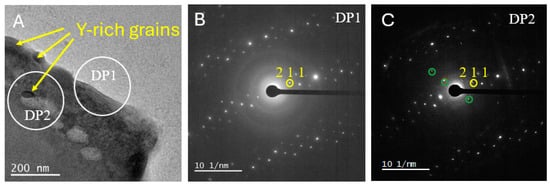
Figure 13.
(A) Porous edge of zircon grain. The area overlaps with Figure 9D; the Y-rich grains in this figure are also highlighted in Figure 9D. (B,C) Diffraction patterns from the selected areas, DP1 and DP2, marked with white circles in (A). Both diffraction patterns show a symmetric pattern corresponding to zircon (the zircon 2 1 1 spot is marked with a yellow circle). The diffraction pattern from area DP 2 shows an additional set of spots (marked with the green circles) that most likely arises from the Y-rich grain. The inner spots of the set have d-spacing = 3.05 Å.
3.3. EELS
EELS analysis was conducted on a select portion of the zircon grain and the mixed-mineral assemblage on the edge of the crystal to complement the EDS analysis with additional chemical information. The TEM-EELS element maps of the Si K, Y L3, and Zr L3 edges (Figure 14C) confirm the high Si and Zr within the zircon and the paucity of Si and relative enrichment of Y in the nanominerals on the edge. It is evident from the element map and the Si-Zr-Y composite that Y enrichment is not confined to the nanominerals; rather, it is distributed at the surface of the zircon. Further, Si concentration, while depleted in the minerals on the edge, increases in their surroundings, as evidenced by the red color spatial distribution in the composite Si/Zr/Y map. Because of the thickness of the region mapped by EELS (t/λ = 1.5), REE elements at trace concentrations could not be confirmed.
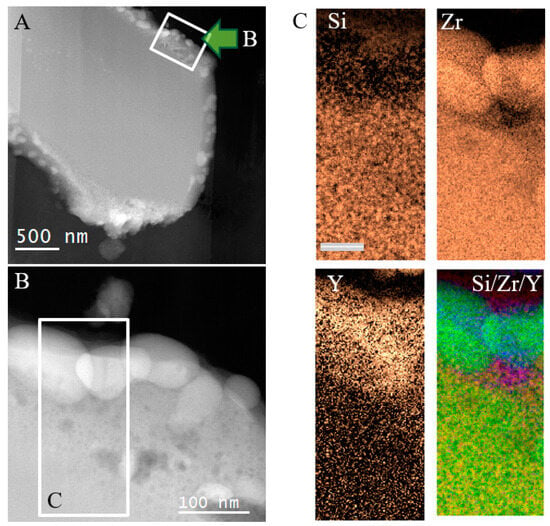
Figure 14.
(A) STEM image of Zircon with mixed-mineral edge showing location of inset (B). Scale = 500 nm. (B) Expanded view of the area of interest with inset C showing the location of the EELS element maps. Scale = 100 nm. (C) STEM-EELS element maps of Si, Zr, Y, and the Si/Zr/Y element overlay map. Scale = 50 nm (shown on Si map).
A dual EELS spectrum (Figure 15) was collected from the same mineral used to collect EDS spot 48 (Figure 9G). The LL region of the spectrum shows the zero-loss peak positioned at zero energy, assuring the correct energy position of the diagnostic ionization edges in the HL region of the spectrum and yielding a relative thickness of 0.53 t/λ. Consistently with EDS, the Y edge is the most intense in the HL region of the spectrum, while no clear Zr edge can be identified, and the Si edge is near background level. The P edge is not marked in the figure because it cannot be confidently deconvolved from the Y edge features; therefore, its presence cannot be discerned. After subtracting the background, the Er M5 edge (1409 eV) is clearly visible above the background, while Yb is suggested by a weak peak just above the background (Yb M5 at 1528 eV). In EDS, Er overlaps with the Fe Kβ peak, effectively making it impossible to detect low concentrations of Er since Fe is always present at low concentrations in TEM-EDS spectra due to instrument contributions.

Figure 15.
Dual EELS spectrum from the point-marked EELS 13. The low-loss region (LL) shows the zero-loss peak and plasmon peaks used to correct for shift and determine relative thickness of 0.53 t/ʎ. In the high-loss region (HL, the blue line shows the unprocessed spectrum, the red line the modeled background, and the green line the background-subtracted spectrum. A well-defined Y ionization edge, minor Si edge, and a clear Er edge (1409 eV) are evident in the spectrum. The position of the Zr edge is marked to highlight that it is absent. A small peak at 1526 eV suggests Yb.
4. Discussion
The earlier investigation of the beneficiated fly ash studied here and of the post-acid-extracted spent fly ash (after refs. [20,22]) focused on the REE + Y + Sc in monazite and other REE-rich minerals and in the Al-Si fly ash glass [6]. In this study, the focus is on the zircons and associated minerals in the beneficiated fly ash. An SEM-EDS analysis of the latter suite allowed further study to be concentrated on an Hf-bearing zircon with a suite of REE (albeit, with some obscured by Ti and Fe EDS peaks), relatively strong Y peaks (both the Lα and Kα peaks), and the suggestion of an Nb peak on the shoulder of the Zr Lα peak (Figure 5 and Figure 6).
TEM examination of the FIB liftout demonstrated that the grain consisted of a solid zircon core (Figure 9G, spot EDS 39) with a porous edge with Y-rich areas (Figure 9C–E and Figure 10). The area 55 analysis (location in Figure 9B; element maps in Figure 10; EDS spectra in Figure 11) demonstrates that the zircon crystal dominates the overall chemistry, but that Y and, possibly, Yb and Ho are minor components.
What is the origin and significance of the porous edge of the zircon? The zircons in the fly ash were inherited from the feed coal, which, in turn, inherited the zircons from detrital sediments in the peat swamp and/or from volcanic ashes. Since the Fire Clay coal, with a well-documented volcanic ash-fall parting [8], might have been a component of the coal blend, as suggested by the REE profile of the ash [6,7], a volcanic + detrital source is likely. In either case, zircons can be recycled through multiple generations, with the core zircons serving as nuclei for the generation of the growth of new mineral layers [9,16,27]. In the case of the mineral in this study, the new layer was a fergusonite-zircon-yttriaite-baddeleyite (?) mix (it is noted that the latter mineral assemblage is a feature of this coal source and the resulting fly ash; it might not be present in the zone zircons from other coal sources). In particular, EDS points 41 and 38 (location in Figure 9G,H; EDS spectra in Figure 12) illustrate the complexity of the Y and REE concentrations in the minerals. EELS analysis (Figure 14) also demonstrates the variable Si/Zr/Y distributions on the porous edge.
While fergusonite could not be definitively identified by diffraction (Figure 13), it is known that radionuclides in zircon and fergusonite can, upon radioactive decay, develop a metamict structure thus partially or entirely destroying the crystal structure. Heating metamict zircon and fergusonite to temperatures above 1100 °C (the latter being below coal-combustion temperatures) can result in a porous texture [14,15]. In contrast, even though transformation to zirconia and cristobalite can begin below 1300 °C [12], the uniform structure of the zircon observed here suggests that its mineralogy remained unchanged from the structure present in the feed coal.
The absence of a thicker fergusonite-zircon-yttriaite-baddeleyite rind could mean that (1) it was not present in the feed coal or (2) that the transformation of metamict minerals to a porous structure meant that the (likely) brittle structure was abraded away in the turbulent gas/particle mix in the boiler and convective pass. In the case of the second option, the particles would still be part of the fly ash, just not attached to the zircon grain.
5. Conclusions
Rare-earth-rich minerals and REE-bearing Al-Si glass were investigated in the beneficiated fly ash and the post-acid-extracted spent fly ash by Berti et al. [6]. In this study, the element distributions in Hf-bearing zircons and related Y- and REE-bearing minerals in the beneficiated fly ash. The study progressed through an SEM-EDS screening of Zr-bearing minerals; to the selection of a promising mineral assemblage for FIB liftout and TEM examination; to the TEM-EDS, SAED, and EELS examination of the minerals. The findings are as follows:
- TEM-EDS examination of the mineral assemblage showed that a solid zircon core was surrounded by a porous edge with Y- and heavy-REE-bearing minerals.
- The porous edge may be a consequence of the coal combustion-driven heating of metamict zircon and Y-bearing minerals with damaged crystal structures. Within the zircon core, even though some phase changes [12], the uniform structure of the mineral suggests that the zircon mineralogy remained unchanged.
- In spite of the potential damage to the mineral crystallinity in the metamict rim of the zircon, minerals, including zircon, are present. The SAED mineralogy of very fine minerals was not definitive, but the diffraction patterns point towards the presence of fergusonite (YNbO4) and yttriaite (Y2O3).
- Not inconsequential to the fate of zircons and the associated minerals in the coal-fired boiler is their origin. Zircons, having a detrital and/or volcanic source, are inherited from the feed coal. In some cases, the zircons in the coal developed over the course of multiple generations, with the core mineral serving as the nuclei for the successive growth of new layers. In the case of the minerals under investigation here, it is proposed that the fergusonite–zircon–yttriaite–baddeleyite (?) rind surrounding the zircon contained small amounts of radionuclides (although none were seen in significant amounts in the EDS study), which, upon decay, damaged the structure of the minerals, leading to the porosity of the mineral aggregates upon heating and the abrading of mineral assemblages in the turbulence of the gas/particle mix in the boiler. The abraded particles are collectively part of the fly ash, but they are no longer attached to the original zircon grains.
Supplementary Materials
The following supporting information can be downloaded at: https://www.mdpi.com/article/10.3390/min15050461/s1, Table S1: 2025 zircon supplementary files SEM and TEM EDS and EELS data.
Author Contributions
Conceptualization, D.B. and J.C.H.; methodology, D.B. and J.C.H.; validation, D.B. and J.C.H.; formal analysis, S.D.H., T.D.M., D.B. and J.C.H.; D.B. and J.C.H. resources, J.G.G., T.B., M.S., D.B. and J.C.H.; writing—original draft preparation, D.B. and J.C.H.; writing—all authors; supervision, B.Z.; project administration, B.Z.; funding acquisition, B.Z., D.B., P.J., D.V.P. and D.P.G. All authors have read and agreed to the published version of the manuscript.
Funding
The pilot-scale beneficiation and extraction of the fly ash was supported by the U.S. Department of Energy under Award DE-FE0027167. This report was prepared as an account of work sponsored by an agency of the United States Government. Neither the United States Government nor any agency thereof, nor any of their employees makes any warranty, express or implied, or assumes any legal liability or responsibility for the accuracy, completeness, or usefulness of any information, apparatus, product, or process disclosed, or represents that its use would not infringe privately owned rights. Reference herein to any specific commercial product, process, or service by trade name, trademark, manufacturer, or otherwise does not necessarily constitute or imply its endorsement, recommendation, or favoring by the United States Government or any agency thereof. The views and opinions of authors expressed herein do not necessarily state or reflect those of the United States Government or any agency thereof. Scanning and transmission electron microscopy were conducted at the Center for Microscopy and Imaging of Baylor University, Waco, Texas. Purchase of the BioContinuum HD imaging filter and K3 single-electron detector was supported in part by Cancer Prevention Research Institute of Texas grant RR220081 awarded to Jonathan A. Clinger.
Data Availability Statement
Data are included in the supplementary files.
Conflicts of Interest
Author P.J., D.V.P. and D.P.G. were employed by the company Physical Sciences Inc. The remaining authors declare that the research was conducted in the absence of any commercial or financial relationships that could be construed as a potential conflict of interest.
References
- Mills, S. Rare Earth Elements—Recovery from Coal-Based Materials; ICSC/334; International Centre for Sustainable Carbon: London, UK, 2024; p. 96. [Google Scholar]
- Hower, J.C.; Kolker, A.; Hsu-Kim, H.; Plata, D.L. Rare earth elements in coal combustion fly ash and their potential recovery. In Rare Earth Elements: Sustainable Processing, Purification and Recovery; Karamalidis, A.K., Eggert, R.G., Eds.; American Geophysical Union Special Publication; John Wiley & Sons, Inc.: Washington, DC, USA, 2025; Volume 79, pp. 25–71. [Google Scholar]
- US Department of Energy. Critical Minerals and Materials Program: Project Portfolio. 2023. Available online: https://netl.doe.gov/sites/default/files/2024-04/Final%202023%20CM%20Project%20Portfolio%20032924.pdf (accessed on 16 December 2024).
- US Department of Energy. Project Selections for FOA 3077: Regional Scale Collaboration to Facilitate a Domestic Critical Minerals Future: Carbon Ore, Rare Earth, and Critical Minerals (CORE-CM) Initiative—Round 1. 2025. Available online: https://www.energy.gov/fecm/project-selections-foa-3077-regional-scale-collaboration-facilitate-domestic-critical-minerals (accessed on 23 January 2025).
- Hower, J.C.; Cantando, E.; Eble, C.F.; Copley, G.C. Characterization of stoker ash from the combustion of high-lanthanide coal at a Kentucky bourbon distillery. Int. J. Coal Geol. 2019, 213, 103260. [Google Scholar] [CrossRef]
- Berti, D.; Groppo, J.G.; Joshi, P.; Preda, D.V.; Gamliel, D.P.; Beers, T.; Schrock, M.; Hopps, S.D.; Morgan, T.D.; Zechmann, B.; et al. Electron microbeam investigations of the spent ash from the pilot-scale acid extraction of rare earth elements from a beneficiated Kentucky fly ash. Int. J. Coal Geol. 2025, 303, 104738. [Google Scholar] [CrossRef]
- Hower, J.C.; Groppo, J.G.; Hsu-Kim, H.; Taggart, R.K. Signatures of Rare Earth Element distributions in fly ash derived from the combustion of Central Appalachian, Illinois, and Powder River basin coals. Fuel 2021, 301, 121048. [Google Scholar] [CrossRef]
- Liu, J.; Dai, S.; Berti, D.; Eble, C.F.; Dong, M.; Gao, Y.; Hower, J.C. Rare earth and critical element chemistry of the volcanic ash-fall parting in the Fire Clay coal, eastern Kentucky, USA. Clays Clay Miner. 2023, 71, 309–339. [Google Scholar] [CrossRef]
- Hay, D.C.; Dempster, T.J.; Lee, M.R.; Brown, D.J. Anatomy of a low temperature zircon outgrowth. Contrib. Mineral. Petrol. 2010, 159, 81–92. [Google Scholar] [CrossRef]
- Drost, K.; Wirth, R.; Košler, J.; Jørgensen, H.F.; Ntaflos, T. Chemical and structural relations of epitaxial xenotime and zircon substratum in sedimentary and hydrothermal environments: A TEM study. Contrib. Mineral. Petrol. 2013, 165, 737–756. [Google Scholar] [CrossRef]
- Berti, D.; Slowey, N.C.; Yancey, T.E.; Deng, Y. Rare earth nanominerals in bentonite deposits of the Eocene Texas coastal plains. Appl. Clay Sci. 2022, 216, 106373. [Google Scholar] [CrossRef]
- Quercia, G.; Perera, Y.; Tovar, H.; Rodriguez, E. Thermal degradation of zirconium silicate (ZrSiO4) ferrules. Acta Microsc. 2007, 16, 205–206. [Google Scholar]
- Butterman, W.C.; Foster, W.R. Zircon stability and the ZrO2-SiO2 phase diagram. Am. Mineral. 1967, 52, 880–885. [Google Scholar]
- Salje, E.K.H.; Chrosch, J.; Ewing, R.C. Is ‘metamictization’ of zircon a phase transition? Am. Mineral. 1999, 84, 107–1116. [Google Scholar] [CrossRef]
- Chen, R.; Siidra, O.I.; Firsova, V.A.; Ugolkov, V.L.; Vlasenko, N.S.; Bocharov, V.N.; Arevalo-Lopez, A.M.; Colmont, M.; Tokarev, I.V. Thermal evolution of the metamict fergusonite-(Y). Phys. Chem. Miner. 2024, 51, 8. [Google Scholar] [CrossRef]
- Siégel, C.; Bryan, S.E.; Allen, C.M.; Gust, D.A. Use and abuse of zircon-based thermometers: A critical review and a recommended approach to identify antecrystic zircons. Earth Sci. Rev. 2018, 176, 87–116. [Google Scholar] [CrossRef]
- Hikichi, Y.; Nomura, T. Melting temperatures of monazite and xenotime. J. Am. Ceram. Soc. 1987, 70, C252–C253. [Google Scholar] [CrossRef]
- Roth, R.S. (Ed.) Phase Equilibria Diagrams, Vol. XI: Oxides; American Ceramic Society: Westerville, OH, USA, 1995; p. 487. [Google Scholar]
- Fabrichnaya, O.; Wang, C.; Zinkevich, M.; Aldinger, F.; Levi, C.G. Phase equilibria and thermodynamic properties of the ZrO2-GdO1.5-YO1.5 system. J. Phase Equilibria Diffus. 2005, 26, 591–604. [Google Scholar] [CrossRef]
- Hower, J.C.; Groppo, J.G.; Joshi, P.; Preda, D.V.; Gamliel, D.P.; Mohler, D.T.; Wiseman, J.D.; Hopps, S.D.; Morgan, T.D.; Beers, T.; et al. Distribution of Lanthanides, Yttrium, and Scandium in the pilot-scale beneficiation of fly ashes derived from eastern Kentucky coals. Minerals 2020, 10, 105. [Google Scholar] [CrossRef]
- Joshi, P.B.; Preda, D.V.; Skyler, D.A.; Tsinberg, A.; Green, B.D.; Marinelli, W.J. Recovery of Rare Earth Elements and Compounds from Coal Ash. U.S. Patent 8,968,688, 2015. Available online: https://patentimages.storage.googleapis.com/b1/76/40/96ade5301b206b/US8968688.pdf (accessed on 20 March 2025).
- Hower, J.C.; Groppo, J.G.; Jewell, R.F.; Wiseman, J.D.; Duvallet, T.Y.; Oberlink, A.E.; Hopps, S.D.; Morgan, T.D.; Henke, K.R.; Joshi, P.; et al. Distribution of Rare earth elements in the pilot-scale processing of fly ashes derived from eastern Kentucky coals: Comparisons of the feed and processed ashes. Fuel 2021, 295, 120562. [Google Scholar] [CrossRef]
- Scott, J.; Thomas, P.J.; MacKenzie, M.; McFadzean, S.; Wilbrink, J.; Craven, A.J.; Nicholson, W.A.P. Near-simultaneous dual energy range EELS spectrum imaging. Ultramicroscopy 2008, 108, 1586. [Google Scholar] [CrossRef] [PubMed]
- Malis, T.; Cheng, S.C.; Egerton, R.F. EELS log ratio technique for specimen-thickness measurement in the TEM. J. Electron Microsc. Tech. 1988, 8, 193. [Google Scholar] [CrossRef] [PubMed]
- Stroud, R.M.; Singerling, S.A. Fundamentals of transmission electron microscopy in earth and planetary sciences. In Treatise on Geochemistry, 3rd ed.; Elsevier: Amsterdam, The Netherlands, 2025; Volume 8, pp. 861–881. [Google Scholar]
- Marks, S. What Makes TEM EDS Different from SEM EDS? Oxford Instruments 2022. Available online: https://www.oxinst.com/blogs/what-makes-tem-eds-different-from-sem-eds (accessed on 27 January 2025).
- Ramdohr, P. The Ore Minerals and Their Intergrowths, 2nd ed.; Pergamon: Oxford, UK, 1980; p. 1207. [Google Scholar]
- Webmineral.com. 2025. Available online: https://www.webmineral.com/ (accessed on 28 January 2025).
- Minedat.org. 2025. Available online: https://www.mindat.org/ (accessed on 28 January 2025).
Disclaimer/Publisher’s Note: The statements, opinions and data contained in all publications are solely those of the individual author(s) and contributor(s) and not of MDPI and/or the editor(s). MDPI and/or the editor(s) disclaim responsibility for any injury to people or property resulting from any ideas, methods, instructions or products referred to in the content. |
© 2025 by the authors. Licensee MDPI, Basel, Switzerland. This article is an open access article distributed under the terms and conditions of the Creative Commons Attribution (CC BY) license (https://creativecommons.org/licenses/by/4.0/).